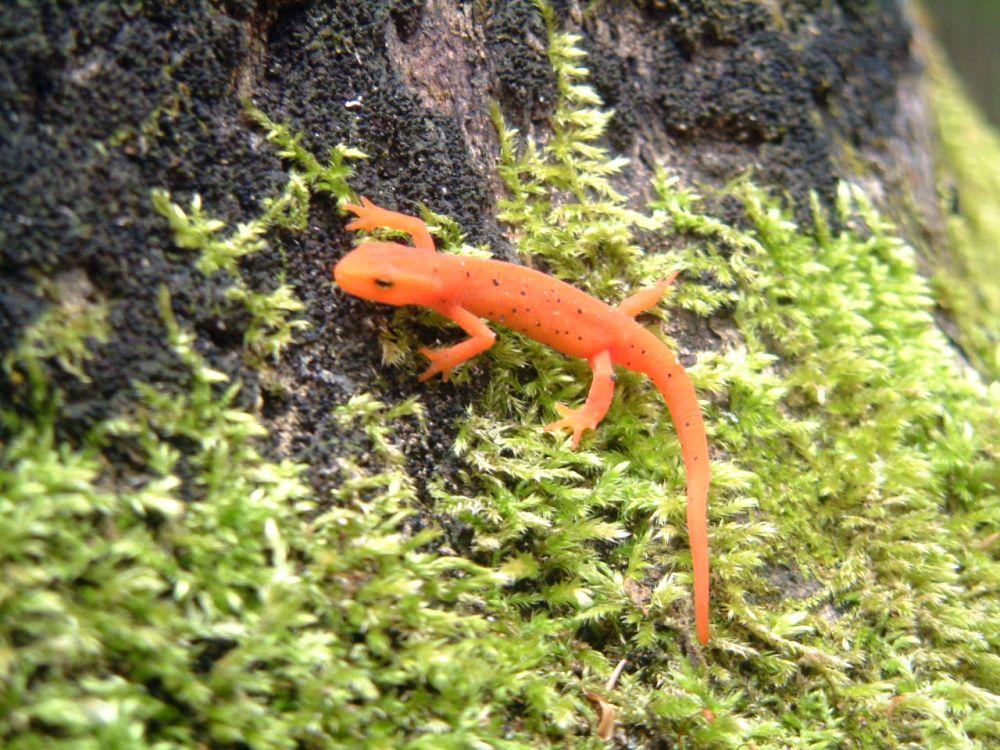Forest Journal
- Tags:
- Wildlife

Red Eft prowling the moss. Photo by Dave Anderson
WALKING in New Hampshire woods, I'm usually looking up and looking out. Tall trees, flitting birds overhead and the possibility of dozing deer or a bounding bear keep my chin up. My destinations are viewing spots on a summit ledges or a scenic waterfall along a brook - features that naturally draw my gaze ever-outward.
Hikers are upwardly mobile.
Exceptions occur when lugging a too-heavy pack or when bone-weary at the end of a long day. That's when I trudge head down, just watching my boots negotiate rocks and fallen logs, lest I tumble. I try to avoid hiking eight hours to reach the dim view found at the legendary Point of Exhaustion.
On aging hips and knees, quality time in the woods is now more likely a short walk before work in familiar backyard woods. And tumbling to the forest floor might not be so bad if I lie still long enough to see the forest in miniature - a new perspective on woods now revealed to be not as familiar as I'd once thought.
July was our fourth wettest on record in many parts of the state. New Hampshire didn't experience prolonged periods of rain, but short bursts of tropical downpours left forests sodden with temporary brooks and streams still running.

The rains brought a flush of bright mushrooms, lush ferns, frogs and seemingly thousands of salamanders to the mossy carpeting of the forest floor. This summer, I'm spending more time looking down ... sometimes even lying down. Did I mention the aging thing?
I've only just begun to appreciate the architecture of mushrooms, lichens and mosses amid a stunning variety of insects inhabiting the "miniature forest" at my feet. There's a microscopic wilderness in the leaf litter - a Lilliputian layer - where soil is built from fallen leaves, seeds and rotting wood. This perspective eludes lofty hikers thundering through the forest at 3 mph.
With eyeballs fixed at a dizzying altitude of 5 feet 6 inches, we miss a gazillion dramas in which legions of intricate ants, centipedes, spiders and beetles bustle beneath arching fern fronds in dense shade on the forest floor.
After rain or morning dew, neon-orange salamanders hunt snow fleas. The salamanders are eastern newts (pronounced in British accent by Monty Python fans). These "red efts" are a juvenile stage of the eastern red-spotted newt, our most common salamander of Granite State lakes, ponds and marshes. Like tigers in the leaves, red efts are stalkers, their prey tiny insects on the cool, moist forest floor. They continue this pursuit for as many as seven years before transforming into familiar aquatic adults - olive green with red spots and bright yellow bellies.
The conspicuous orange newts have immunity from predators; their skin contains unpalatable chemicals and a powerful toxin, a chemical defense strategy also employed by toads. Monarch butterflies also display an orange toxic warning label to would-be predators.
Frogs are more numerous in the wet woods this summer. Wood frogs, spring peepers and gray tree frogs - even green frogs more typically found in wet meadows and ponds - are feasting on forest insects in terrain that is typically too dry by late summer. Male green frogs are distinguished from females by ear drums larger than their eyes. Golden flecks in the outer iris of a frog's aqueous eye provides a portal into their watery realm.
The mushrooms are fantastic this summer. Wet soil and spongy, rotting wood are ablaze with mold. Conspicuous fruiting mushrooms arise from myriad fungal "hyphae."These unseen microscopic threads form a continuous mat that is intimately connected into the root tissues of towering trees and other plants. In exchange for tapping into plant sugars, the fungi increase root surface area and the efficiency of nutrient and water absorption by larger plants, including huge trees. So flop down like Gulliver on a carpet of soft leaves, green ferns or damp moss along a brook. Take a closer look ...

Rich, dark living humus of forest soil provides a kaleidoscope of beauty and diversity. Insects, earthworms and fungi break down rotting vegetation to form new soil. Predatory amphibians and large insects hunt smaller insects. These ecological epics occur in a few square meters of forest floor. They are essential to the health of forests, which supply our oxygen, clean drinking water and raw wood fiber.
It's these little things that rule the world!
